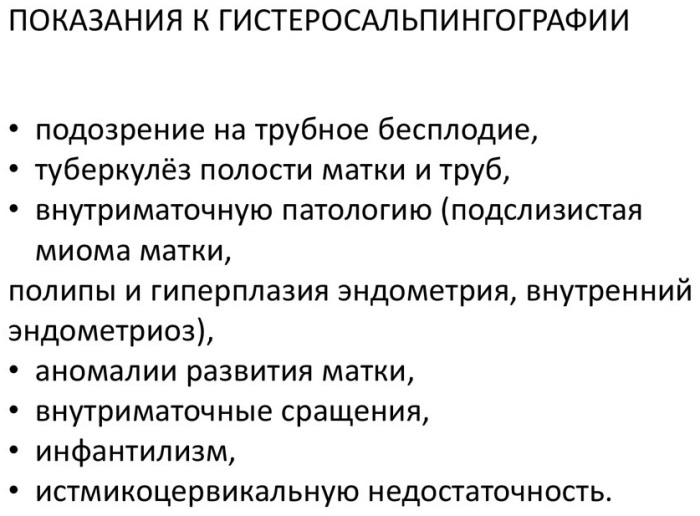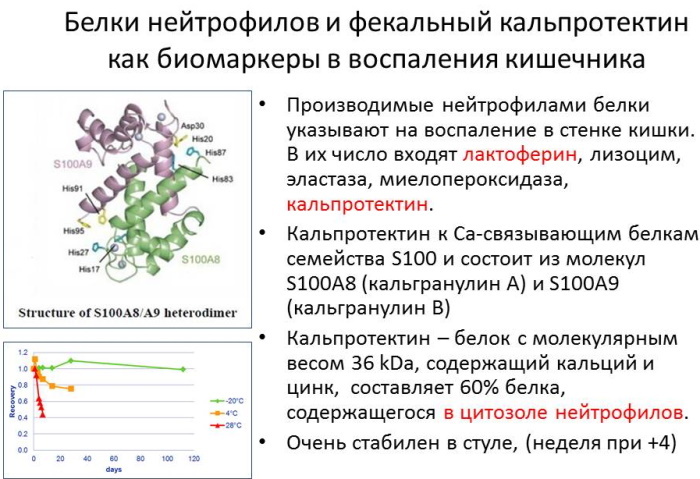Content
- What is CPAP Therapy and Mechanism of Action
- Indications
- Contraindications
- Selection of a comfortable mask
- Selection of a comfortable initial pressure level
- CPAP therapy equipment
- How is a CPAP trial session done?
- Long Term CPAP Therapy
- Duration of therapy
- Side effects of CPAP therapy
- Positive changes in patients' well-being during CPAP therapy
- Treatment cost
- Video about CPAP therapy
CPAP (in English displayed in the form of the abbreviation CPAP) therapy is an effective method of maintaining a stable pressure and ventilation of the respiratory system of a person who may suddenly stop breathing during sleep. This method of hardware treatment was developed by Australian doctors in the 80s of the last century.
Currently, CPAP therapy is actively used in inpatient departments of most medical institutions specializing in the treatment of patients with sleep apnea syndrome, as well as other concomitant pathologies that are accompanied by impaired respiratory function during sleep and at the time of falling asleep.
What is CPAP Therapy and Mechanism of Action
CPAP (CPAP) - therapy is translated from English as "continuous airway pressure". This term is simultaneously used to designate the name of equipment that ensures uninterrupted supply of pressure to the human bronchopulmonary system.

In fact, CPAP therapy is a hardware method for treating sudden respiratory arrest during sleep that occurs in people suffering from sleep apnea. Violation of stable ventilation of the lungs is possible due to anatomical defects of the larynx, pathological proliferation of tissues in the area of the hard palate or due to degenerative changes in the structure of the pharyngeal tonsils.
The mechanism of action of the CPAP therapy technique is that the CPAP apparatus continuously supplies oxygen to the cavity of the patient's respiratory system. As soon as a person connected to this equipment stops breathing, the automation maintains an optimal level pressure inside the ventilation system, saturating the trachea and bronchial tree of the patient with the required volume air.
The patient continues to sleep soundly, and his body does not experience negative symptoms of oxygen starvation. Due to the effective action of the CPAP system, it is possible to maintain the stability of the patient's blood gas exchange, to prevent the onset of sudden death as a result of sleep apnea.
Indications
The primary indicator for the use of CPAP therapy is the presence of severe snoring in the patient, which is present during daytime and nighttime sleep. At the same time, treatment with the use of the CPAP apparatus is indicated for people who suffer from cardiovascular diseases associated with respiratory dysfunctions.
Based on the results of the preliminary examination of the patient, the doctor-somnologist may prescribe CPAP therapy in the following cases:
- the lack of effectiveness of other methods of treatment that have been used to get rid of sleep apnea attacks against the background of snoring;
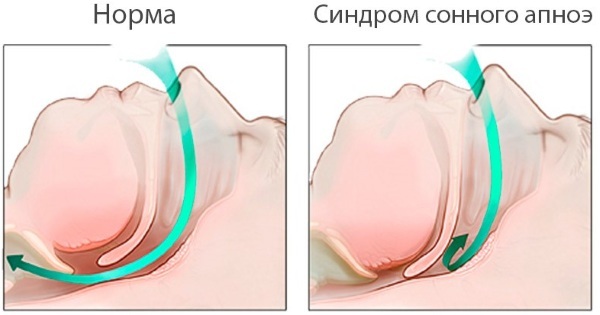
- coronary heart disease with the risk of sudden respiratory arrest during sleep;
- previous myocardial infarction;
- the apnea index is at least 10 s for 1 hour (during this period of time in a dream, the patient completely stops spontaneous breathing);
- hypertonic disease.
Depending on the general health of the patient, CPAP therapy can be used in the presence of other severe diseases of the respiratory and cardiovascular systems. In this case, the decision on the advisability of connecting the patient to the CPAP device is made by the attending physician on an individual basis.
Contraindications
CPAP therapy is a non-invasive and safe procedure aimed at maintaining stable blood gas exchange.
The method of treatment has the following contraindications for its use:
- history of pneumothorax;
- violation of the integrity of the pleural membrane of the lungs;
- accumulation of excess air inside the tissue of the mediastinum;
- pneumocephalus (the ingress of oxygen into the cranial cavity, which occurs under the influence of the compression pressure of the CPAP apparatus);
- inflammatory processes in the maxillary sinuses and other paranasal cavities;
- chronic or acute eye diseases that are infectious in origin;
- previous surgical operations on brain tissues, including therapeutic manipulations in various parts of the pituitary gland;
- heart failure in a state of decompensation;
- pathologically low blood pressure indicators, which significantly reduce the quality of human life, disrupt the functions of the cardiovascular system and internal organs;
- frequent occurrence of nosebleeds, the nature of the origin of which has not been established even after a comprehensive diagnosis of the body.
Before deciding to connect the patient to the CPAP equipment, the doctor-somnologist examines the patient for the possible presence of the above contraindications. An assessment of the potential risk of side effects is performed.
Selection of a comfortable mask
The selection of an oxygen mask, which will come into contact with the skin surface of the patient's face, must be performed with the direct participation of a somnologist. A specialist of this profile will help you choose the most comfortable components for the CPAP compressor, taking into account the anatomical features of the patient's face structure.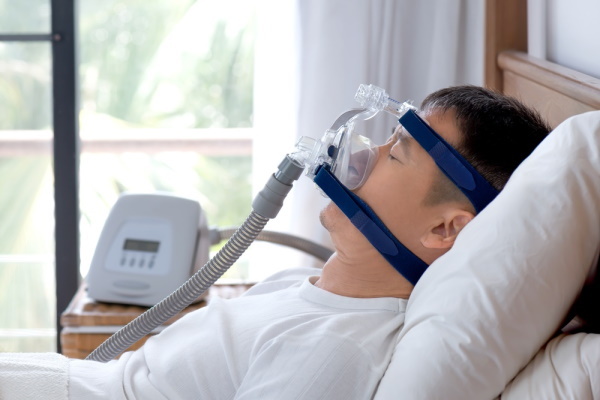
It should be remembered that the mask for CPAP therapy must meet the following criteria:
- made only of high quality polymeric materials that are hypoallergenic;
- comfortable shape that follows the contours of the patient's facial disc;
- the material of which the mask is made does not collect condensation that forms during the act of breathing, or as a result of humidification by the CPAP system;
- the product fits snugly to the surface of the face, ensuring complete tightness (otherwise under the influence of pressure of the compressor, a constant air leak will occur, and the patient will not receive the required volume oxygen);
- convenient fixation on the surface of the face, allowing you to quickly install the mask, as well as remove it in case of urgent need;
- absence of an unpleasant chemical smell from the material from which the oxygen mask is made.
A comfortable CPAP mask should fit snugly around the patient's face without exerting excessive pressure on the skin. Constant squeezing of epithelial tissues with an oxygen mask over time will cause side effects in the form of local irritation, redness, atrophic changes in the epidermis.
Selection of a comfortable initial pressure level
The comfortable pressure level, which is created by the CPAP device, is selected by the doctor-somnologist individually for each patient, depending on the functional state of his respiratory and cardiovascular systems.
To obtain the initial information, the doctor of this profile examines the patient. Based on the diagnostic results, the CPAP therapy apparatus is adjusted. In the process of treating obstructive sleep apnea, depending on the patient's well-being, the functions of the compressor equipment are adjusted.
CPAP therapy equipment
Modern equipment for CPAP therapy is represented by several types of compressor devices, which are used to treat patients with obstructive apnea syndrome. The table below describes the main types of CPAP systems intended for long-term operation.
| CPAP equipment type | Basic characteristics of the ventilator |
| Standard CPAP compressors | This type of equipment is the simplest system for creating a stable pressure in the human respiratory organs. With the help of devices of this type, oxygen is pumped into the cavity of the bronchial tree on a constant basis. At the same time, this equipment is not equipped with automatic sensors for determining the phase of a person's breathing. The absence of this function significantly reduces the patient's comfort level. The oxygen supply is maintained even at a time when a person is not bothered by another attack of obstructive apnea. The advantages of standard CPAP compressors include only the simplicity of their operation, as well as their affordable cost. The average price of this equipment is around $ 25,000. rub. Most of the models are gradually being phased out from industrial production, as they are obsolete. |
| BIPAP | BIPAP is an apparatus for creating a stable pressure inside the bronchopulmonary system of a person, as well as saturating his body with an additional amount of oxygen. A distinctive feature of the model is that it is a two-phase compressor. An increase in pressure in the respiratory organs occurs at the time of inhalation. On exhalation, the compression in the lungs is automatically reduced. The presence of this function of BIPAP equipment improves the quality of the patient's sleep, it is possible to completely get rid of any discomfort. The devices adapt to the physiological rhythm of the human respiratory system. The average cost of BIPAP equipment is in the range of 45-55 thousand. rub. |
| Auto-CPAP | Compressors of this type are innovative devices that are equipped with a large number of breathing sensors and modern automated air supply control. Auto-CPAP equipment starts working only when the patient has another episode of obstructive apnea. As soon as the electronics of the CPAP system detects that the patient has stopped breathing, the compressor starts immediately and builds up the required pressure level for a few seconds. The device maintains the patient's respiratory system in a functional state. The average cost of Auto-CPAP compressors reaches 90-120 thous. rub. |
A standard CPAP device is equipped with a compressor, connecting hoses, an oxygen mask, and an electric power supply unit.
Two-phase and automatic equipment for CPAP therapy is characterized by the presence of additional options in the form of:
- Smartflex. Automated change of the pressure level in the system, taking into account the phase of a person's breathing.
- Air heating. The function of the device is intended for patients prone to inflammatory processes in the respiratory system. It is used in the cold season, while sleeping outdoors.
-
Moisturizing. Allows you to get rid of the side effects of CPAP devices in the form of drying out, cracking and atrophy of the mucous membranes of the oral cavity, larynx, nasal canals.
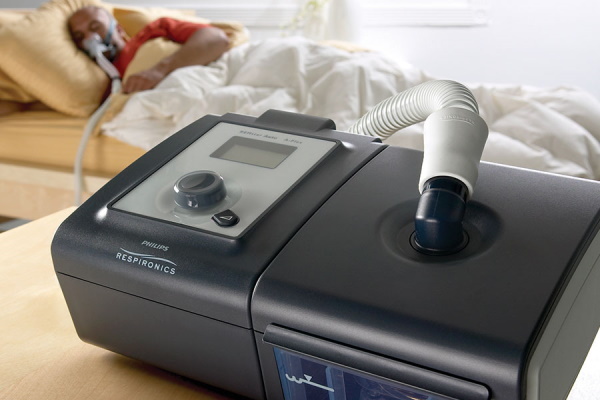
CPAP therapy devices have different dimensions. There is a choice of compressor for stationary use at home, use on business trips or long journeys. CPAP equipment is produced, which is powered from the electrical network, as well as on the basis of rechargeable batteries.
How is a CPAP trial session done?
A trial session of CPAP therapy is carried out in 2 stages. At the initial stage of apparatus treatment, the doctor-somnologist collects initial information about the functional state of the patient's respiratory and cardiovascular systems. Then the doctor proceeds to the next stage in the form of connecting the patient to the CPAP device.
A trial CPAP session includes the following steps:
- The patient comes to the doctor-somnologist for a planned consultation and examination.
- After the diagnosis, the patient remains in the hospital of the medical institution.
- The patient is placed in a ward equipped with technical equipment for fixing the level of performance of the respiratory and cardiovascular systems.
- A polysomnograph apparatus equipped with electronic sensors is connected to the patient's body.
- The performance of the patient's muscles participating in the act of breathing, heart rate, position in bed, functional activity of bronchopulmonary tissue are recorded.
The collection of the above data occurs while the patient is sleeping. Due to this, the doctor receives the most objective information about the work of the patient's body throughout the night. A day later, the doctor adjusts the CPAP device taking into account the initial data read from the polysomnograph.
The patient connects to CPAP therapy equipment and then falls asleep. In the morning, the doctor-somnologist is interested in the patient's condition, the quality of his sleep, the presence or absence of discomfort at night. If there are any comments, the CPAP functions of the equipment are adjusted in the direction of increasing or decreasing the initial pressure.
Long Term CPAP Therapy
Patients requiring long-term CPAP therapy undergo the first course of treatment in a hospital in a medical institution. Then the patient receives a detailed consultation with a sleep doctor with recommendations for purchasing CPAP device of a certain type, which is necessary for the effective treatment of a patient with a specific diagnosis. The patient continues further therapy at home.
At the same time, the receiving doctor-somnologist conducts further support of the patient, adjusts the CPAP equipment, selects the optimal mode of its operation. The therapeutic device is installed near the patient's bed on a bedside table or table surface. The advantage of the CPAP system is its portability. The device easily moves from one room to another, does not require additional settings.
Duration of therapy
CPAP therapy is a therapeutic technique that provides for a constant mechanical effect on the respiratory system of a sick person. With this method of dealing with obstructive sleep apnea syndrome, it is impossible to achieve a long-term effect that will persist even after the use of CPAP equipment is discontinued.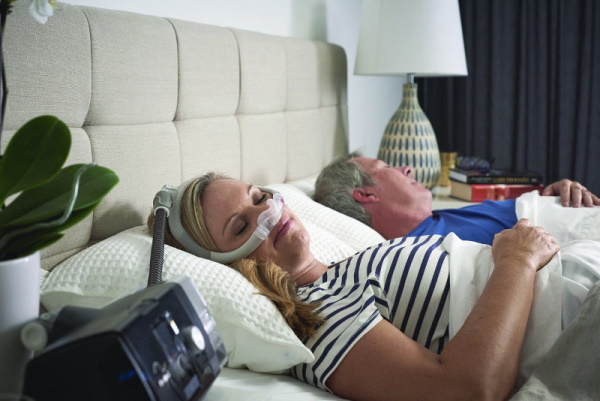
A patient who refuses to continue using CPAP therapy, starts snoring again during sleep, and is faced with periodic manifestations of obstructive apnea. The cumulative effect from the use of the CPAP device is insignificant, or even completely absent.
Patients who suffer from snoring, respiratory arrest during nighttime or daytime sleep should use CPAP therapy for life. Therefore, the choice of CPAP equipment should be balanced, with the direct participation of a somnologist.
Side effects of CPAP therapy
CPAP therapy is a medical procedure that is well tolerated by most patients of all age groups.
In the process of using the CPAP device, side effects periodically occur:
- irritation of the skin of the face in the area of its contact with the edges of the oxygen mask (these consequences most often manifested in patients with sensitive skin prone to allergic reactions to external irritants);
- increased dryness of the mucous membrane of the nasal canals, eyeballs and oral cavity;
- rhinitis of unknown etiology without signs of a cold or diseases of an infectious nature of origin;
- persistent nasal congestion, which appears immediately after the completion of the therapeutic procedure;
- arrhythmia, tachycardia attacks and other disorders of the functions of the organs of the cardiovascular system.
In most cases, the above side effects from the use of the CPAP device appear during the first 2-3 days from the start of CPAP therapy. A patient who has discovered signs of a painful state of the body should immediately report the incident to his attending somnologist. The doctor will examine the patient, and then decide on the advisability of further CPAP therapy.
Positive changes in patients' well-being during CPAP therapy
CPAP therapy is a modern method of air compression of the lungs, which allows you to get rid of obstructive apnea syndrome during the daytime or nighttime sleep.
Regular implementation of this treatment procedure allows patients to achieve the following positive changes in overall well-being:
- elimination of pathological symptoms of hypertension;
- stabilize heart rate and improve general blood circulation in the vessels;
- getting rid of snoring, regardless of its nature of origin;
- improve performance and cope with chronic fatigue syndrome;
- improve concentration, activate the thought process and memory functions;
- normalize the process of sleeping and falling asleep.
Most patients with obstructive sleep apnea who were treated with CPAP therapy note the absolute safety and comfort of this method. After awakening from sleep, the patients felt rested, vigorous, full of strength and vitality.
Treatment cost
The average cost of taking a CPAP therapy course is from 4900 rubles. In most cases, this medical service is provided by privately owned medical institutions. The price of a therapeutic course using CPAP equipment can be changed by the clinic's management, depending on the patient's age, the presence of concomitant diseases of the cardiovascular system, the risk of developing side effects.
CPAP therapy is an effective method of normalizing sleep and falling asleep in people who suffer from snoring and obstructive sleep apnea. This method of treatment is aimed at maintaining a stable gas exchange of the patient's blood at a time when his bronchopulmonary system does not provide the body with a sufficient volume of oxygen. Apnea against the background of snoring can last from 10 to 30 seconds.
At this time, the CPAP device supplies air to the patient's respiratory system, creating artificial pressure necessary for full ventilation of the lungs. Patients undergoing treatment with CPAP therapy feel a noticeable improvement in their general well-being, they always wake up refreshed and refreshed. The main advantage of this method of treatment is to reduce the risk of sudden death, the onset of which is possible in people with obstructive sleep apnea.
Video about CPAP therapy
Doctor about CPAP therapy:

